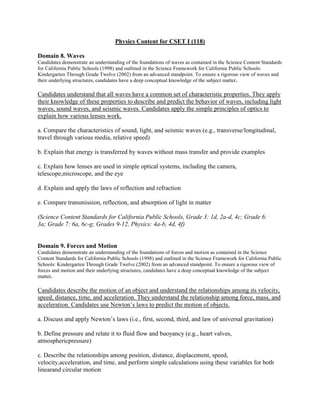
Ddd physics content for 118
- 1. Physics Content for CSET I (118) Domain 8. Waves Candidates demonstrate an understanding of the foundations of waves as contained in the Science Content Standards for California Public Schools (1998) and outlined in the Science Framework for California Public Schools: Kindergarten Through Grade Twelve (2002) from an advanced standpoint. To ensure a rigorous view of waves and their underlying structures, candidates have a deep conceptual knowledge of the subject matter. Candidates understand that all waves have a common set of characteristic properties. They apply their knowledge of these properties to describe and predict the behavior of waves, including light waves, sound waves, and seismic waves. Candidates apply the simple principles of optics to explain how various lenses work. a. Compare the characteristics of sound, light, and seismic waves (e.g., transverse/longitudinal, travel through various media, relative speed) b. Explain that energy is transferred by waves without mass transfer and provide examples c. Explain how lenses are used in simple optical systems, including the camera, telescope,microscope, and the eye d. Explain and apply the laws of reflection and refraction e. Compare transmission, reflection, and absorption of light in matter (Science Content Standards for California Public Schools, Grade 3: 1d, 2a-d, 4c; Grade 6: 3a; Grade 7: 6a, 6c-g; Grades 9-12, Physics: 4a-b, 4d, 4f) Domain 9. Forces and Motion Candidates demonstrate an understanding of the foundations of forces and motion as contained in the Science Content Standards for California Public Schools (1998) and outlined in the Science Framework for California Public Schools: Kindergarten Through Grade Twelve (2002) from an advanced standpoint. To ensure a rigorous view of forces and motion and their underlying structures, candidates have a deep conceptual knowledge of the subject matter. Candidates describe the motion of an object and understand the relationships among its velocity, speed, distance, time, and acceleration. They understand the relationship among force, mass, and acceleration. Candidates use Newton’s laws to predict the motion of objects. a. Discuss and apply Newton’s laws (i.e., first, second, third, and law of universal gravitation) b. Define pressure and relate it to fluid flow and buoyancy (e.g., heart valves, atmosphericpressure) c. Describe the relationships among position, distance, displacement, speed, velocity,acceleration, and time, and perform simple calculations using these variables for both linearand circular motion
- 2. d. Identify the separate forces that act on a body (e.g., gravity, pressure, tension/compression,normal force, friction) and describe the net force on the body e. Construct and analyze simple vector and graphical representations of motion and forces (e.g., distance, speed f. Identify fundamental forces, including gravity, nuclear forces, and electromagnetic forces(magnetic and electric), and explain their roles in nature, such as the role of gravity inmaintaining the structure of the universe g. Explain and calculate mechanical advantages for levers, pulleys, and inclined planes (Science Content Standards for California Public Schools, Grade 7: 6h-j; Grade 8: 1a-f, 2ag) Domain 10. Electricity and Magnetism Candidates demonstrate an understanding of the foundations of the electricity and magnetism contained in the Science Content Standards for California Public Schools (1998) as outlined in the Science Framework for California Public Schools: Kindergarten Through Grade Twelve (2002) from an advanced standpoint. To ensure a rigorous view of electricity and magnetism and their underlying structures, candidates have a deep conceptual knowledge of the subject matter. Candidates understand that electric and magnetic phenomena are related. They use knowledge of electricity and magnetism to explain many practical applications. a. Describe and provide examples of electrostatic and magnetostatic phenomena b. Predict charges or poles based on attraction/repulsion observations c. Build a simple compass and use it to determine direction of magnetic fields, including theEarth’s magnetic field d. Relate electric currents to magnetic fields and describe the application of theserelationships, such as in electromagnets, electric current generators, motors, andtransformers e. Design and interpret simple series and parallel circuits f. Define and calculate power, voltage differences, current, and resistance in simple circuits (Science Content Standards for California Public Schools, Grade 4: 1a-g; Grade 9-12, Physics: 5a-c)